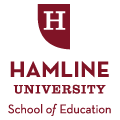Term
Spring 5-13-2016
Capstone
Thesis
Degree Name
MAED: NSEE
Primary Advisor/Dissertation Chair
Jason Miller
Secondary Advisor/Reader One
Courtney Kowalczak
Peer-Reviewer/Reader Two
Elyse Carter Vosen
Abstract
American Indian youth face many adversities. Suicide rates are among the highest in the country. High school graduation rates are the lowest in the country. Many American Indian youth grow up in foster care and some find themselves in juvenile detention centers or gangs. Furthermore, tribal communities are experiencing a shortage of American Indians in the workforce who are equipped with the knowledge and skills they need to fill essential positions that sustain the natural resources that are important to the tribe. There are many efforts in Indian Country to be proactive with American Indian youth, providing them with supports to get on a positive path and pursue higher education. The Gidaakiimanaaniwigamig STEM camp is one such effort. This study takes a closer look at the structures of this camp which support Native American youth to be successful. A focus group is conducted with students who participate in the Gidaakiimanaaniwigamig STEM camp along with individual, structured interviews with parents, students and teachers. The qualitative study outlines six major benefits the youth get from attending the “Gidaa” camp. These benefits include supportive relationships, cultural ownership, development of 21st century skills, having access to new experiences, exposure to science, technology, engineering and math and having aspirations for the future.
Research Methodology
Focus Group, Interview, Observation
Keywords
At-risk Students, Environmental Studies, Multicultural Education, Science
Recommended Citation
Paitrick, Kyra Jo, "Benefits Provided To American Indian Youth Through Gidaakiimanaaniwigamig Stem Camps" (2016). School of Education and Leadership Student Capstone Theses and Dissertations. 4141.
https://digitalcommons.hamline.edu/hse_all/4141

